Nursing Care of the Patient with Hypovolemic Shock
VerifiedAdded on 2022/10/14
|10
|2952
|217
AI Summary
This article discusses the nursing care of the patient with hypovolemic shock, including assessment, priority problem, nursing interventions, and psychological issues. It also provides information on the causes and symptoms of hypovolemic shock. The patient in the case study has multiple fatal disorders and is prone to hypovolemic shock. The article emphasizes the importance of effective nursing intervention and fluid replacement.
Contribute Materials
Your contribution can guide someone’s learning journey. Share your
documents today.
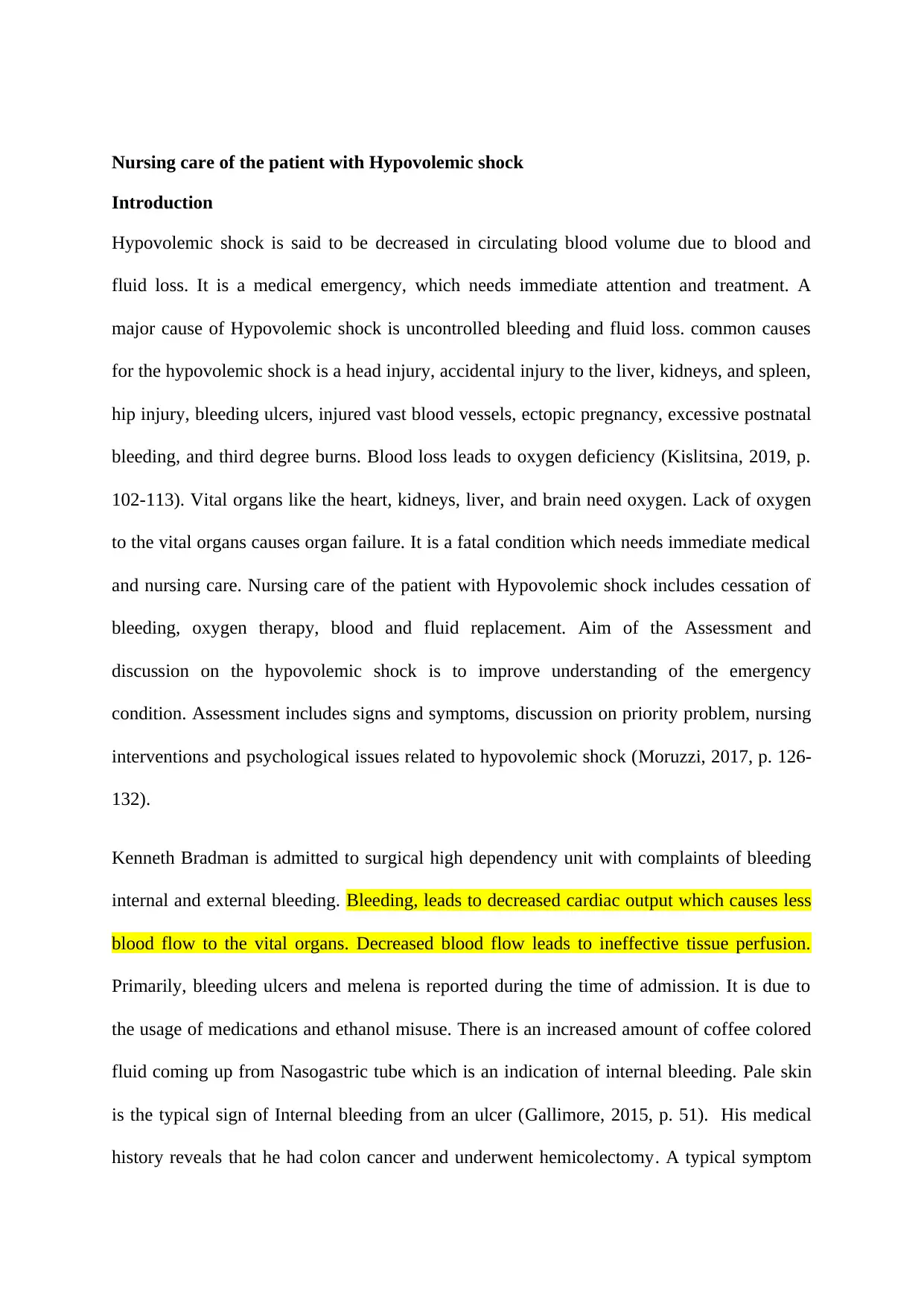
Nursing care of the patient with Hypovolemic shock
Introduction
Hypovolemic shock is said to be decreased in circulating blood volume due to blood and
fluid loss. It is a medical emergency, which needs immediate attention and treatment. A
major cause of Hypovolemic shock is uncontrolled bleeding and fluid loss. common causes
for the hypovolemic shock is a head injury, accidental injury to the liver, kidneys, and spleen,
hip injury, bleeding ulcers, injured vast blood vessels, ectopic pregnancy, excessive postnatal
bleeding, and third degree burns. Blood loss leads to oxygen deficiency (Kislitsina, 2019, p.
102-113). Vital organs like the heart, kidneys, liver, and brain need oxygen. Lack of oxygen
to the vital organs causes organ failure. It is a fatal condition which needs immediate medical
and nursing care. Nursing care of the patient with Hypovolemic shock includes cessation of
bleeding, oxygen therapy, blood and fluid replacement. Aim of the Assessment and
discussion on the hypovolemic shock is to improve understanding of the emergency
condition. Assessment includes signs and symptoms, discussion on priority problem, nursing
interventions and psychological issues related to hypovolemic shock (Moruzzi, 2017, p. 126-
132).
Kenneth Bradman is admitted to surgical high dependency unit with complaints of bleeding
internal and external bleeding. Bleeding, leads to decreased cardiac output which causes less
blood flow to the vital organs. Decreased blood flow leads to ineffective tissue perfusion.
Primarily, bleeding ulcers and melena is reported during the time of admission. It is due to
the usage of medications and ethanol misuse. There is an increased amount of coffee colored
fluid coming up from Nasogastric tube which is an indication of internal bleeding. Pale skin
is the typical sign of Internal bleeding from an ulcer (Gallimore, 2015, p. 51). His medical
history reveals that he had colon cancer and underwent hemicolectomy. A typical symptom
Introduction
Hypovolemic shock is said to be decreased in circulating blood volume due to blood and
fluid loss. It is a medical emergency, which needs immediate attention and treatment. A
major cause of Hypovolemic shock is uncontrolled bleeding and fluid loss. common causes
for the hypovolemic shock is a head injury, accidental injury to the liver, kidneys, and spleen,
hip injury, bleeding ulcers, injured vast blood vessels, ectopic pregnancy, excessive postnatal
bleeding, and third degree burns. Blood loss leads to oxygen deficiency (Kislitsina, 2019, p.
102-113). Vital organs like the heart, kidneys, liver, and brain need oxygen. Lack of oxygen
to the vital organs causes organ failure. It is a fatal condition which needs immediate medical
and nursing care. Nursing care of the patient with Hypovolemic shock includes cessation of
bleeding, oxygen therapy, blood and fluid replacement. Aim of the Assessment and
discussion on the hypovolemic shock is to improve understanding of the emergency
condition. Assessment includes signs and symptoms, discussion on priority problem, nursing
interventions and psychological issues related to hypovolemic shock (Moruzzi, 2017, p. 126-
132).
Kenneth Bradman is admitted to surgical high dependency unit with complaints of bleeding
internal and external bleeding. Bleeding, leads to decreased cardiac output which causes less
blood flow to the vital organs. Decreased blood flow leads to ineffective tissue perfusion.
Primarily, bleeding ulcers and melena is reported during the time of admission. It is due to
the usage of medications and ethanol misuse. There is an increased amount of coffee colored
fluid coming up from Nasogastric tube which is an indication of internal bleeding. Pale skin
is the typical sign of Internal bleeding from an ulcer (Gallimore, 2015, p. 51). His medical
history reveals that he had colon cancer and underwent hemicolectomy. A typical symptom
Secure Best Marks with AI Grader
Need help grading? Try our AI Grader for instant feedback on your assignments.
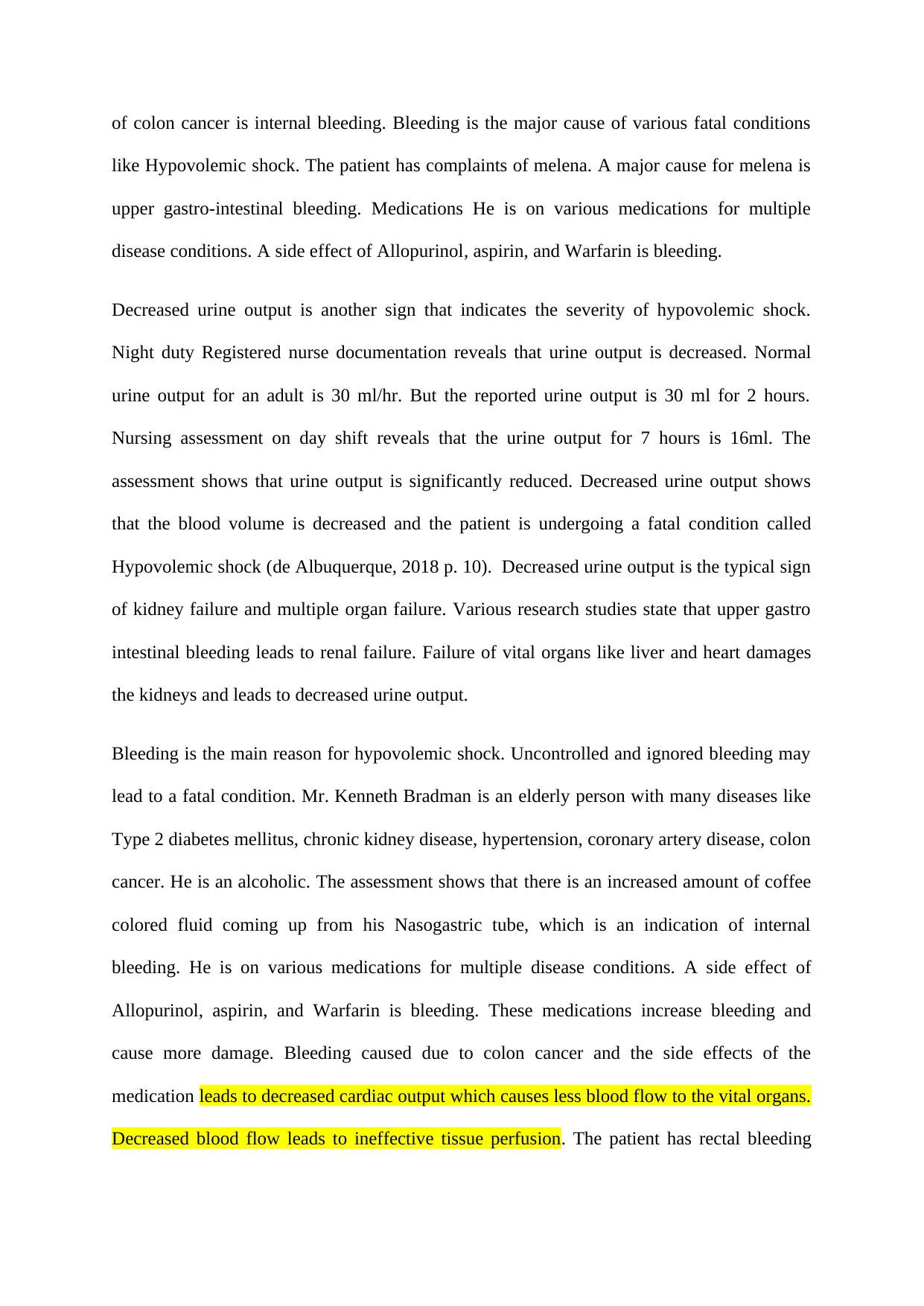
of colon cancer is internal bleeding. Bleeding is the major cause of various fatal conditions
like Hypovolemic shock. The patient has complaints of melena. A major cause for melena is
upper gastro-intestinal bleeding. Medications He is on various medications for multiple
disease conditions. A side effect of Allopurinol, aspirin, and Warfarin is bleeding.
Decreased urine output is another sign that indicates the severity of hypovolemic shock.
Night duty Registered nurse documentation reveals that urine output is decreased. Normal
urine output for an adult is 30 ml/hr. But the reported urine output is 30 ml for 2 hours.
Nursing assessment on day shift reveals that the urine output for 7 hours is 16ml. The
assessment shows that urine output is significantly reduced. Decreased urine output shows
that the blood volume is decreased and the patient is undergoing a fatal condition called
Hypovolemic shock (de Albuquerque, 2018 p. 10). Decreased urine output is the typical sign
of kidney failure and multiple organ failure. Various research studies state that upper gastro
intestinal bleeding leads to renal failure. Failure of vital organs like liver and heart damages
the kidneys and leads to decreased urine output.
Bleeding is the main reason for hypovolemic shock. Uncontrolled and ignored bleeding may
lead to a fatal condition. Mr. Kenneth Bradman is an elderly person with many diseases like
Type 2 diabetes mellitus, chronic kidney disease, hypertension, coronary artery disease, colon
cancer. He is an alcoholic. The assessment shows that there is an increased amount of coffee
colored fluid coming up from his Nasogastric tube, which is an indication of internal
bleeding. He is on various medications for multiple disease conditions. A side effect of
Allopurinol, aspirin, and Warfarin is bleeding. These medications increase bleeding and
cause more damage. Bleeding caused due to colon cancer and the side effects of the
medication leads to decreased cardiac output which causes less blood flow to the vital organs.
Decreased blood flow leads to ineffective tissue perfusion. The patient has rectal bleeding
like Hypovolemic shock. The patient has complaints of melena. A major cause for melena is
upper gastro-intestinal bleeding. Medications He is on various medications for multiple
disease conditions. A side effect of Allopurinol, aspirin, and Warfarin is bleeding.
Decreased urine output is another sign that indicates the severity of hypovolemic shock.
Night duty Registered nurse documentation reveals that urine output is decreased. Normal
urine output for an adult is 30 ml/hr. But the reported urine output is 30 ml for 2 hours.
Nursing assessment on day shift reveals that the urine output for 7 hours is 16ml. The
assessment shows that urine output is significantly reduced. Decreased urine output shows
that the blood volume is decreased and the patient is undergoing a fatal condition called
Hypovolemic shock (de Albuquerque, 2018 p. 10). Decreased urine output is the typical sign
of kidney failure and multiple organ failure. Various research studies state that upper gastro
intestinal bleeding leads to renal failure. Failure of vital organs like liver and heart damages
the kidneys and leads to decreased urine output.
Bleeding is the main reason for hypovolemic shock. Uncontrolled and ignored bleeding may
lead to a fatal condition. Mr. Kenneth Bradman is an elderly person with many diseases like
Type 2 diabetes mellitus, chronic kidney disease, hypertension, coronary artery disease, colon
cancer. He is an alcoholic. The assessment shows that there is an increased amount of coffee
colored fluid coming up from his Nasogastric tube, which is an indication of internal
bleeding. He is on various medications for multiple disease conditions. A side effect of
Allopurinol, aspirin, and Warfarin is bleeding. These medications increase bleeding and
cause more damage. Bleeding caused due to colon cancer and the side effects of the
medication leads to decreased cardiac output which causes less blood flow to the vital organs.
Decreased blood flow leads to ineffective tissue perfusion. The patient has rectal bleeding
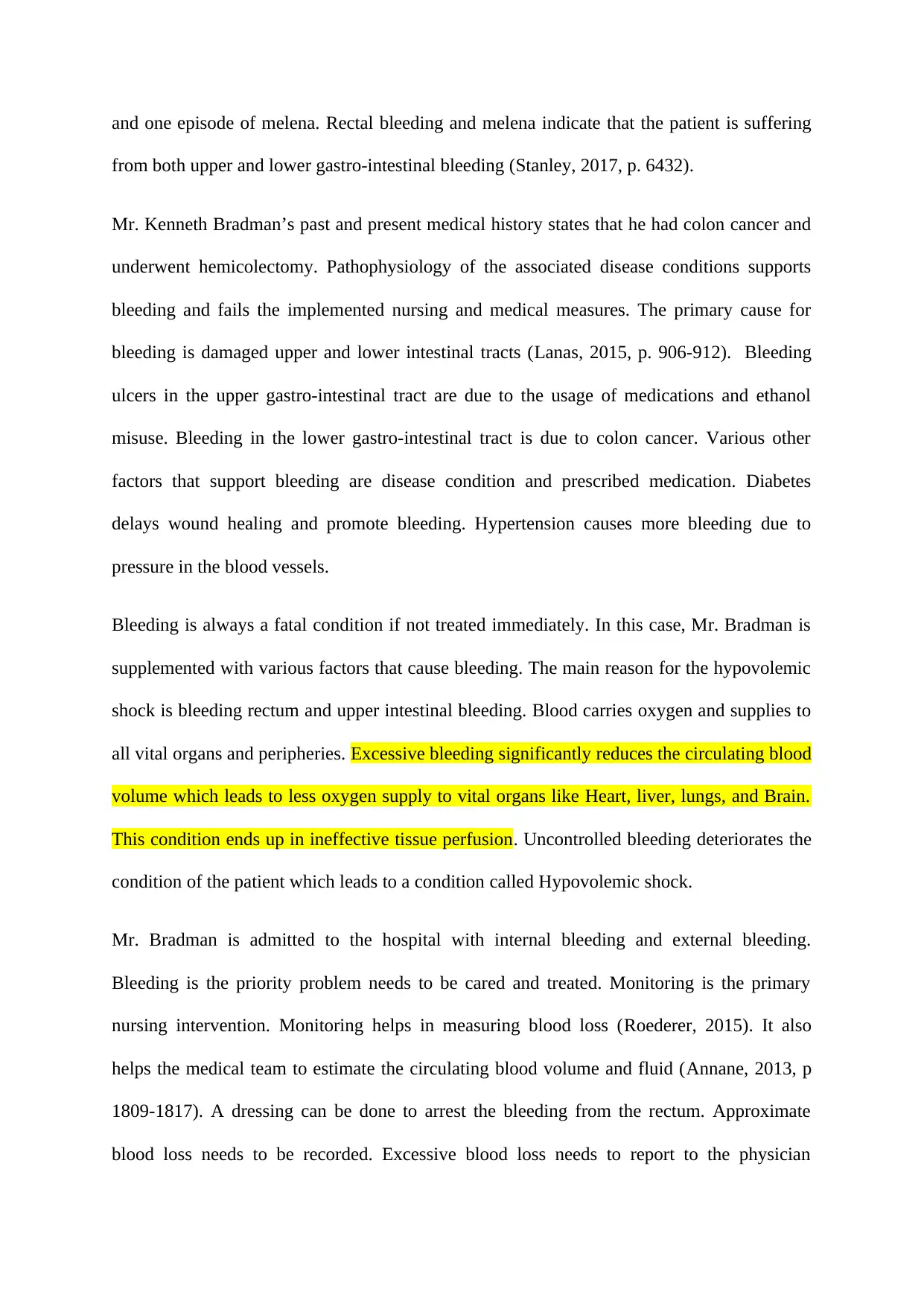
and one episode of melena. Rectal bleeding and melena indicate that the patient is suffering
from both upper and lower gastro-intestinal bleeding (Stanley, 2017, p. 6432).
Mr. Kenneth Bradman’s past and present medical history states that he had colon cancer and
underwent hemicolectomy. Pathophysiology of the associated disease conditions supports
bleeding and fails the implemented nursing and medical measures. The primary cause for
bleeding is damaged upper and lower intestinal tracts (Lanas, 2015, p. 906-912). Bleeding
ulcers in the upper gastro-intestinal tract are due to the usage of medications and ethanol
misuse. Bleeding in the lower gastro-intestinal tract is due to colon cancer. Various other
factors that support bleeding are disease condition and prescribed medication. Diabetes
delays wound healing and promote bleeding. Hypertension causes more bleeding due to
pressure in the blood vessels.
Bleeding is always a fatal condition if not treated immediately. In this case, Mr. Bradman is
supplemented with various factors that cause bleeding. The main reason for the hypovolemic
shock is bleeding rectum and upper intestinal bleeding. Blood carries oxygen and supplies to
all vital organs and peripheries. Excessive bleeding significantly reduces the circulating blood
volume which leads to less oxygen supply to vital organs like Heart, liver, lungs, and Brain.
This condition ends up in ineffective tissue perfusion. Uncontrolled bleeding deteriorates the
condition of the patient which leads to a condition called Hypovolemic shock.
Mr. Bradman is admitted to the hospital with internal bleeding and external bleeding.
Bleeding is the priority problem needs to be cared and treated. Monitoring is the primary
nursing intervention. Monitoring helps in measuring blood loss (Roederer, 2015). It also
helps the medical team to estimate the circulating blood volume and fluid (Annane, 2013, p
1809-1817). A dressing can be done to arrest the bleeding from the rectum. Approximate
blood loss needs to be recorded. Excessive blood loss needs to report to the physician
from both upper and lower gastro-intestinal bleeding (Stanley, 2017, p. 6432).
Mr. Kenneth Bradman’s past and present medical history states that he had colon cancer and
underwent hemicolectomy. Pathophysiology of the associated disease conditions supports
bleeding and fails the implemented nursing and medical measures. The primary cause for
bleeding is damaged upper and lower intestinal tracts (Lanas, 2015, p. 906-912). Bleeding
ulcers in the upper gastro-intestinal tract are due to the usage of medications and ethanol
misuse. Bleeding in the lower gastro-intestinal tract is due to colon cancer. Various other
factors that support bleeding are disease condition and prescribed medication. Diabetes
delays wound healing and promote bleeding. Hypertension causes more bleeding due to
pressure in the blood vessels.
Bleeding is always a fatal condition if not treated immediately. In this case, Mr. Bradman is
supplemented with various factors that cause bleeding. The main reason for the hypovolemic
shock is bleeding rectum and upper intestinal bleeding. Blood carries oxygen and supplies to
all vital organs and peripheries. Excessive bleeding significantly reduces the circulating blood
volume which leads to less oxygen supply to vital organs like Heart, liver, lungs, and Brain.
This condition ends up in ineffective tissue perfusion. Uncontrolled bleeding deteriorates the
condition of the patient which leads to a condition called Hypovolemic shock.
Mr. Bradman is admitted to the hospital with internal bleeding and external bleeding.
Bleeding is the priority problem needs to be cared and treated. Monitoring is the primary
nursing intervention. Monitoring helps in measuring blood loss (Roederer, 2015). It also
helps the medical team to estimate the circulating blood volume and fluid (Annane, 2013, p
1809-1817). A dressing can be done to arrest the bleeding from the rectum. Approximate
blood loss needs to be recorded. Excessive blood loss needs to report to the physician
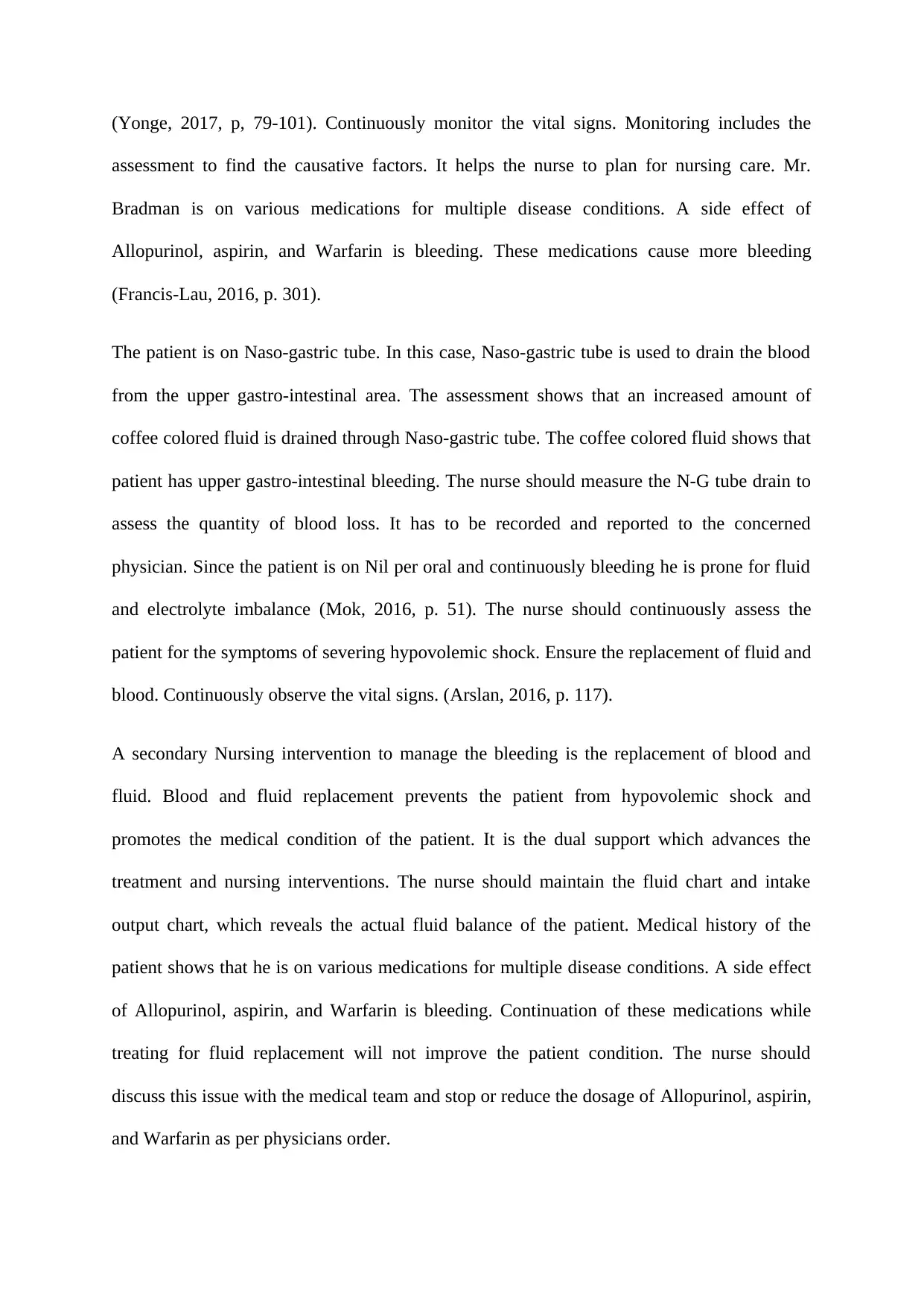
(Yonge, 2017, p, 79-101). Continuously monitor the vital signs. Monitoring includes the
assessment to find the causative factors. It helps the nurse to plan for nursing care. Mr.
Bradman is on various medications for multiple disease conditions. A side effect of
Allopurinol, aspirin, and Warfarin is bleeding. These medications cause more bleeding
(Francis-Lau, 2016, p. 301).
The patient is on Naso-gastric tube. In this case, Naso-gastric tube is used to drain the blood
from the upper gastro-intestinal area. The assessment shows that an increased amount of
coffee colored fluid is drained through Naso-gastric tube. The coffee colored fluid shows that
patient has upper gastro-intestinal bleeding. The nurse should measure the N-G tube drain to
assess the quantity of blood loss. It has to be recorded and reported to the concerned
physician. Since the patient is on Nil per oral and continuously bleeding he is prone for fluid
and electrolyte imbalance (Mok, 2016, p. 51). The nurse should continuously assess the
patient for the symptoms of severing hypovolemic shock. Ensure the replacement of fluid and
blood. Continuously observe the vital signs. (Arslan, 2016, p. 117).
A secondary Nursing intervention to manage the bleeding is the replacement of blood and
fluid. Blood and fluid replacement prevents the patient from hypovolemic shock and
promotes the medical condition of the patient. It is the dual support which advances the
treatment and nursing interventions. The nurse should maintain the fluid chart and intake
output chart, which reveals the actual fluid balance of the patient. Medical history of the
patient shows that he is on various medications for multiple disease conditions. A side effect
of Allopurinol, aspirin, and Warfarin is bleeding. Continuation of these medications while
treating for fluid replacement will not improve the patient condition. The nurse should
discuss this issue with the medical team and stop or reduce the dosage of Allopurinol, aspirin,
and Warfarin as per physicians order.
assessment to find the causative factors. It helps the nurse to plan for nursing care. Mr.
Bradman is on various medications for multiple disease conditions. A side effect of
Allopurinol, aspirin, and Warfarin is bleeding. These medications cause more bleeding
(Francis-Lau, 2016, p. 301).
The patient is on Naso-gastric tube. In this case, Naso-gastric tube is used to drain the blood
from the upper gastro-intestinal area. The assessment shows that an increased amount of
coffee colored fluid is drained through Naso-gastric tube. The coffee colored fluid shows that
patient has upper gastro-intestinal bleeding. The nurse should measure the N-G tube drain to
assess the quantity of blood loss. It has to be recorded and reported to the concerned
physician. Since the patient is on Nil per oral and continuously bleeding he is prone for fluid
and electrolyte imbalance (Mok, 2016, p. 51). The nurse should continuously assess the
patient for the symptoms of severing hypovolemic shock. Ensure the replacement of fluid and
blood. Continuously observe the vital signs. (Arslan, 2016, p. 117).
A secondary Nursing intervention to manage the bleeding is the replacement of blood and
fluid. Blood and fluid replacement prevents the patient from hypovolemic shock and
promotes the medical condition of the patient. It is the dual support which advances the
treatment and nursing interventions. The nurse should maintain the fluid chart and intake
output chart, which reveals the actual fluid balance of the patient. Medical history of the
patient shows that he is on various medications for multiple disease conditions. A side effect
of Allopurinol, aspirin, and Warfarin is bleeding. Continuation of these medications while
treating for fluid replacement will not improve the patient condition. The nurse should
discuss this issue with the medical team and stop or reduce the dosage of Allopurinol, aspirin,
and Warfarin as per physicians order.
Secure Best Marks with AI Grader
Need help grading? Try our AI Grader for instant feedback on your assignments.
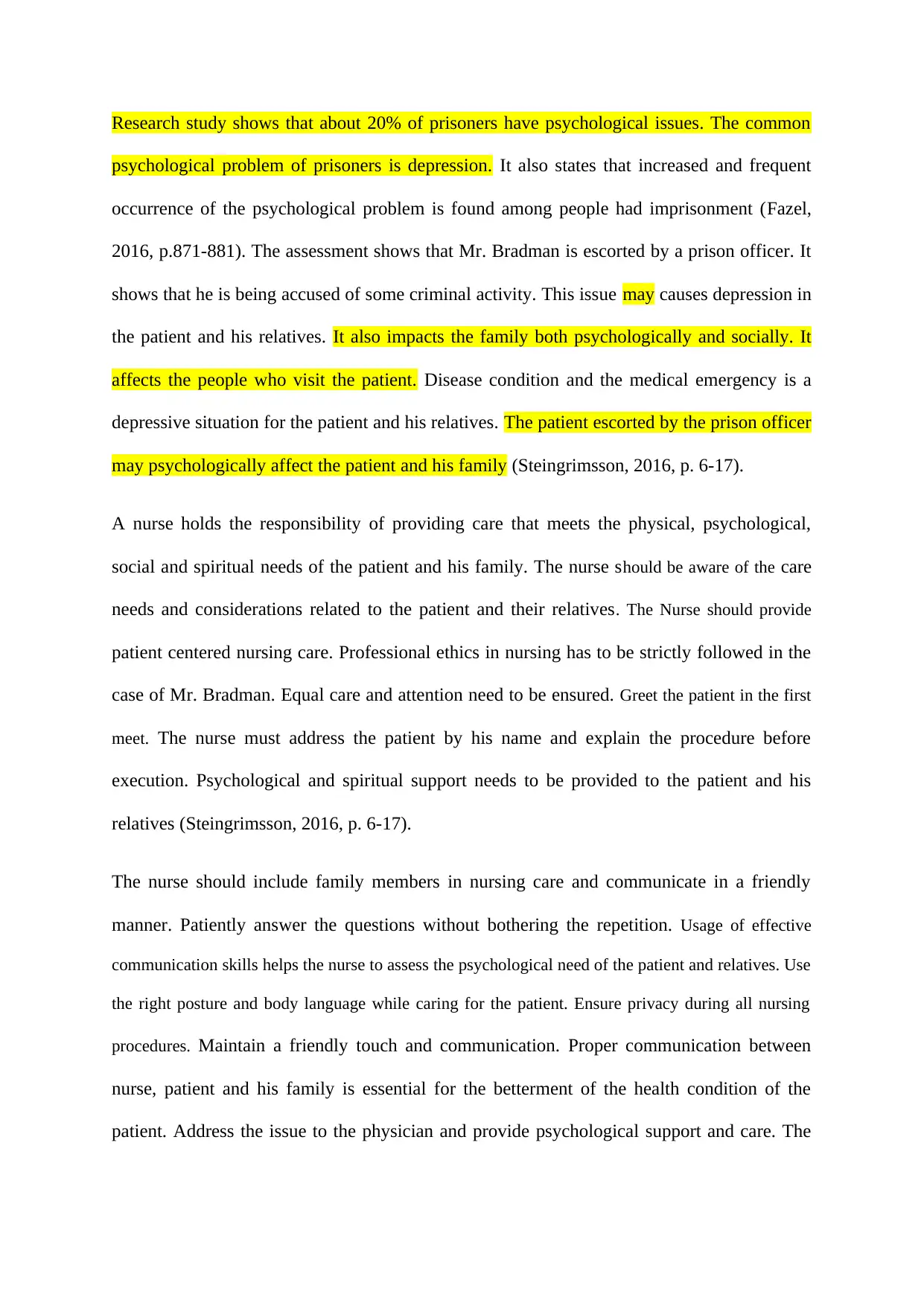
Research study shows that about 20% of prisoners have psychological issues. The common
psychological problem of prisoners is depression. It also states that increased and frequent
occurrence of the psychological problem is found among people had imprisonment (Fazel,
2016, p.871-881). The assessment shows that Mr. Bradman is escorted by a prison officer. It
shows that he is being accused of some criminal activity. This issue may causes depression in
the patient and his relatives. It also impacts the family both psychologically and socially. It
affects the people who visit the patient. Disease condition and the medical emergency is a
depressive situation for the patient and his relatives. The patient escorted by the prison officer
may psychologically affect the patient and his family (Steingrimsson, 2016, p. 6-17).
A nurse holds the responsibility of providing care that meets the physical, psychological,
social and spiritual needs of the patient and his family. The nurse should be aware of the care
needs and considerations related to the patient and their relatives. The Nurse should provide
patient centered nursing care. Professional ethics in nursing has to be strictly followed in the
case of Mr. Bradman. Equal care and attention need to be ensured. Greet the patient in the first
meet. The nurse must address the patient by his name and explain the procedure before
execution. Psychological and spiritual support needs to be provided to the patient and his
relatives (Steingrimsson, 2016, p. 6-17).
The nurse should include family members in nursing care and communicate in a friendly
manner. Patiently answer the questions without bothering the repetition. Usage of effective
communication skills helps the nurse to assess the psychological need of the patient and relatives. Use
the right posture and body language while caring for the patient. Ensure privacy during all nursing
procedures. Maintain a friendly touch and communication. Proper communication between
nurse, patient and his family is essential for the betterment of the health condition of the
patient. Address the issue to the physician and provide psychological support and care. The
psychological problem of prisoners is depression. It also states that increased and frequent
occurrence of the psychological problem is found among people had imprisonment (Fazel,
2016, p.871-881). The assessment shows that Mr. Bradman is escorted by a prison officer. It
shows that he is being accused of some criminal activity. This issue may causes depression in
the patient and his relatives. It also impacts the family both psychologically and socially. It
affects the people who visit the patient. Disease condition and the medical emergency is a
depressive situation for the patient and his relatives. The patient escorted by the prison officer
may psychologically affect the patient and his family (Steingrimsson, 2016, p. 6-17).
A nurse holds the responsibility of providing care that meets the physical, psychological,
social and spiritual needs of the patient and his family. The nurse should be aware of the care
needs and considerations related to the patient and their relatives. The Nurse should provide
patient centered nursing care. Professional ethics in nursing has to be strictly followed in the
case of Mr. Bradman. Equal care and attention need to be ensured. Greet the patient in the first
meet. The nurse must address the patient by his name and explain the procedure before
execution. Psychological and spiritual support needs to be provided to the patient and his
relatives (Steingrimsson, 2016, p. 6-17).
The nurse should include family members in nursing care and communicate in a friendly
manner. Patiently answer the questions without bothering the repetition. Usage of effective
communication skills helps the nurse to assess the psychological need of the patient and relatives. Use
the right posture and body language while caring for the patient. Ensure privacy during all nursing
procedures. Maintain a friendly touch and communication. Proper communication between
nurse, patient and his family is essential for the betterment of the health condition of the
patient. Address the issue to the physician and provide psychological support and care. The
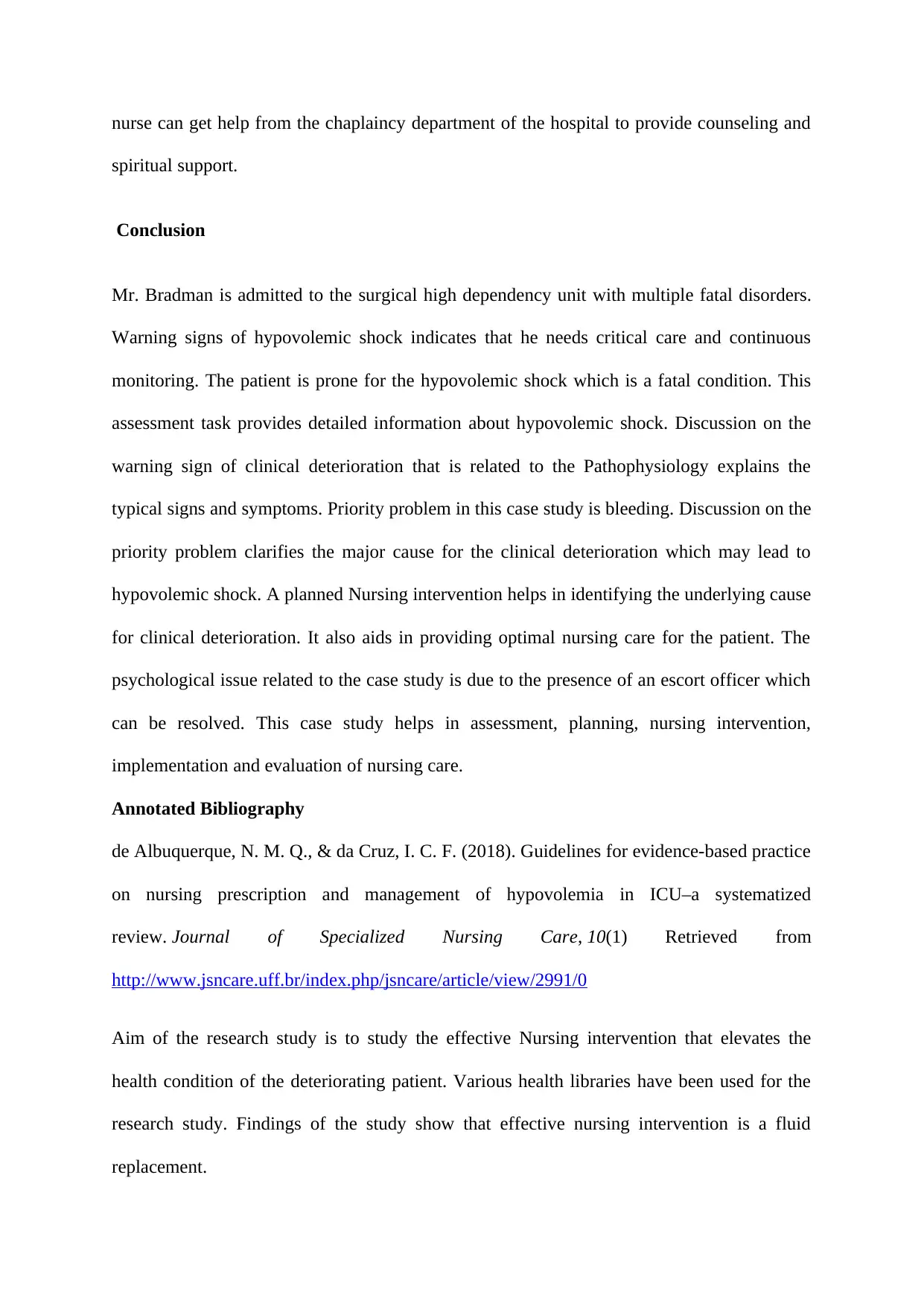
nurse can get help from the chaplaincy department of the hospital to provide counseling and
spiritual support.
Conclusion
Mr. Bradman is admitted to the surgical high dependency unit with multiple fatal disorders.
Warning signs of hypovolemic shock indicates that he needs critical care and continuous
monitoring. The patient is prone for the hypovolemic shock which is a fatal condition. This
assessment task provides detailed information about hypovolemic shock. Discussion on the
warning sign of clinical deterioration that is related to the Pathophysiology explains the
typical signs and symptoms. Priority problem in this case study is bleeding. Discussion on the
priority problem clarifies the major cause for the clinical deterioration which may lead to
hypovolemic shock. A planned Nursing intervention helps in identifying the underlying cause
for clinical deterioration. It also aids in providing optimal nursing care for the patient. The
psychological issue related to the case study is due to the presence of an escort officer which
can be resolved. This case study helps in assessment, planning, nursing intervention,
implementation and evaluation of nursing care.
Annotated Bibliography
de Albuquerque, N. M. Q., & da Cruz, I. C. F. (2018). Guidelines for evidence-based practice
on nursing prescription and management of hypovolemia in ICU–a systematized
review. Journal of Specialized Nursing Care, 10(1) Retrieved from
http://www.jsncare.uff.br/index.php/jsncare/article/view/2991/0
Aim of the research study is to study the effective Nursing intervention that elevates the
health condition of the deteriorating patient. Various health libraries have been used for the
research study. Findings of the study show that effective nursing intervention is a fluid
replacement.
spiritual support.
Conclusion
Mr. Bradman is admitted to the surgical high dependency unit with multiple fatal disorders.
Warning signs of hypovolemic shock indicates that he needs critical care and continuous
monitoring. The patient is prone for the hypovolemic shock which is a fatal condition. This
assessment task provides detailed information about hypovolemic shock. Discussion on the
warning sign of clinical deterioration that is related to the Pathophysiology explains the
typical signs and symptoms. Priority problem in this case study is bleeding. Discussion on the
priority problem clarifies the major cause for the clinical deterioration which may lead to
hypovolemic shock. A planned Nursing intervention helps in identifying the underlying cause
for clinical deterioration. It also aids in providing optimal nursing care for the patient. The
psychological issue related to the case study is due to the presence of an escort officer which
can be resolved. This case study helps in assessment, planning, nursing intervention,
implementation and evaluation of nursing care.
Annotated Bibliography
de Albuquerque, N. M. Q., & da Cruz, I. C. F. (2018). Guidelines for evidence-based practice
on nursing prescription and management of hypovolemia in ICU–a systematized
review. Journal of Specialized Nursing Care, 10(1) Retrieved from
http://www.jsncare.uff.br/index.php/jsncare/article/view/2991/0
Aim of the research study is to study the effective Nursing intervention that elevates the
health condition of the deteriorating patient. Various health libraries have been used for the
research study. Findings of the study show that effective nursing intervention is a fluid
replacement.
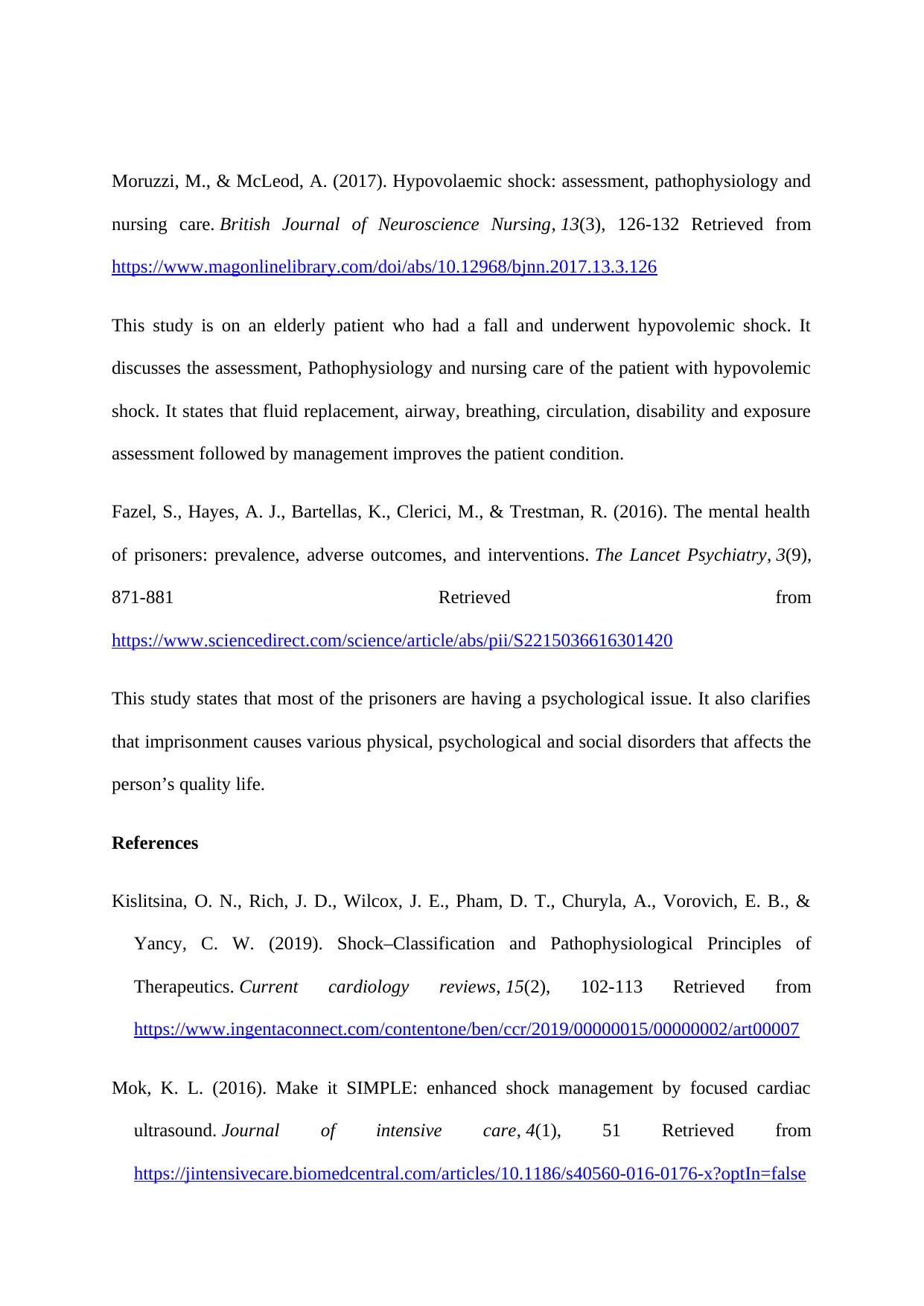
Moruzzi, M., & McLeod, A. (2017). Hypovolaemic shock: assessment, pathophysiology and
nursing care. British Journal of Neuroscience Nursing, 13(3), 126-132 Retrieved from
https://www.magonlinelibrary.com/doi/abs/10.12968/bjnn.2017.13.3.126
This study is on an elderly patient who had a fall and underwent hypovolemic shock. It
discusses the assessment, Pathophysiology and nursing care of the patient with hypovolemic
shock. It states that fluid replacement, airway, breathing, circulation, disability and exposure
assessment followed by management improves the patient condition.
Fazel, S., Hayes, A. J., Bartellas, K., Clerici, M., & Trestman, R. (2016). The mental health
of prisoners: prevalence, adverse outcomes, and interventions. The Lancet Psychiatry, 3(9),
871-881 Retrieved from
https://www.sciencedirect.com/science/article/abs/pii/S2215036616301420
This study states that most of the prisoners are having a psychological issue. It also clarifies
that imprisonment causes various physical, psychological and social disorders that affects the
person’s quality life.
References
Kislitsina, O. N., Rich, J. D., Wilcox, J. E., Pham, D. T., Churyla, A., Vorovich, E. B., &
Yancy, C. W. (2019). Shock–Classification and Pathophysiological Principles of
Therapeutics. Current cardiology reviews, 15(2), 102-113 Retrieved from
https://www.ingentaconnect.com/contentone/ben/ccr/2019/00000015/00000002/art00007
Mok, K. L. (2016). Make it SIMPLE: enhanced shock management by focused cardiac
ultrasound. Journal of intensive care, 4(1), 51 Retrieved from
https://jintensivecare.biomedcentral.com/articles/10.1186/s40560-016-0176-x?optIn=false
nursing care. British Journal of Neuroscience Nursing, 13(3), 126-132 Retrieved from
https://www.magonlinelibrary.com/doi/abs/10.12968/bjnn.2017.13.3.126
This study is on an elderly patient who had a fall and underwent hypovolemic shock. It
discusses the assessment, Pathophysiology and nursing care of the patient with hypovolemic
shock. It states that fluid replacement, airway, breathing, circulation, disability and exposure
assessment followed by management improves the patient condition.
Fazel, S., Hayes, A. J., Bartellas, K., Clerici, M., & Trestman, R. (2016). The mental health
of prisoners: prevalence, adverse outcomes, and interventions. The Lancet Psychiatry, 3(9),
871-881 Retrieved from
https://www.sciencedirect.com/science/article/abs/pii/S2215036616301420
This study states that most of the prisoners are having a psychological issue. It also clarifies
that imprisonment causes various physical, psychological and social disorders that affects the
person’s quality life.
References
Kislitsina, O. N., Rich, J. D., Wilcox, J. E., Pham, D. T., Churyla, A., Vorovich, E. B., &
Yancy, C. W. (2019). Shock–Classification and Pathophysiological Principles of
Therapeutics. Current cardiology reviews, 15(2), 102-113 Retrieved from
https://www.ingentaconnect.com/contentone/ben/ccr/2019/00000015/00000002/art00007
Mok, K. L. (2016). Make it SIMPLE: enhanced shock management by focused cardiac
ultrasound. Journal of intensive care, 4(1), 51 Retrieved from
https://jintensivecare.biomedcentral.com/articles/10.1186/s40560-016-0176-x?optIn=false
Paraphrase This Document
Need a fresh take? Get an instant paraphrase of this document with our AI Paraphraser
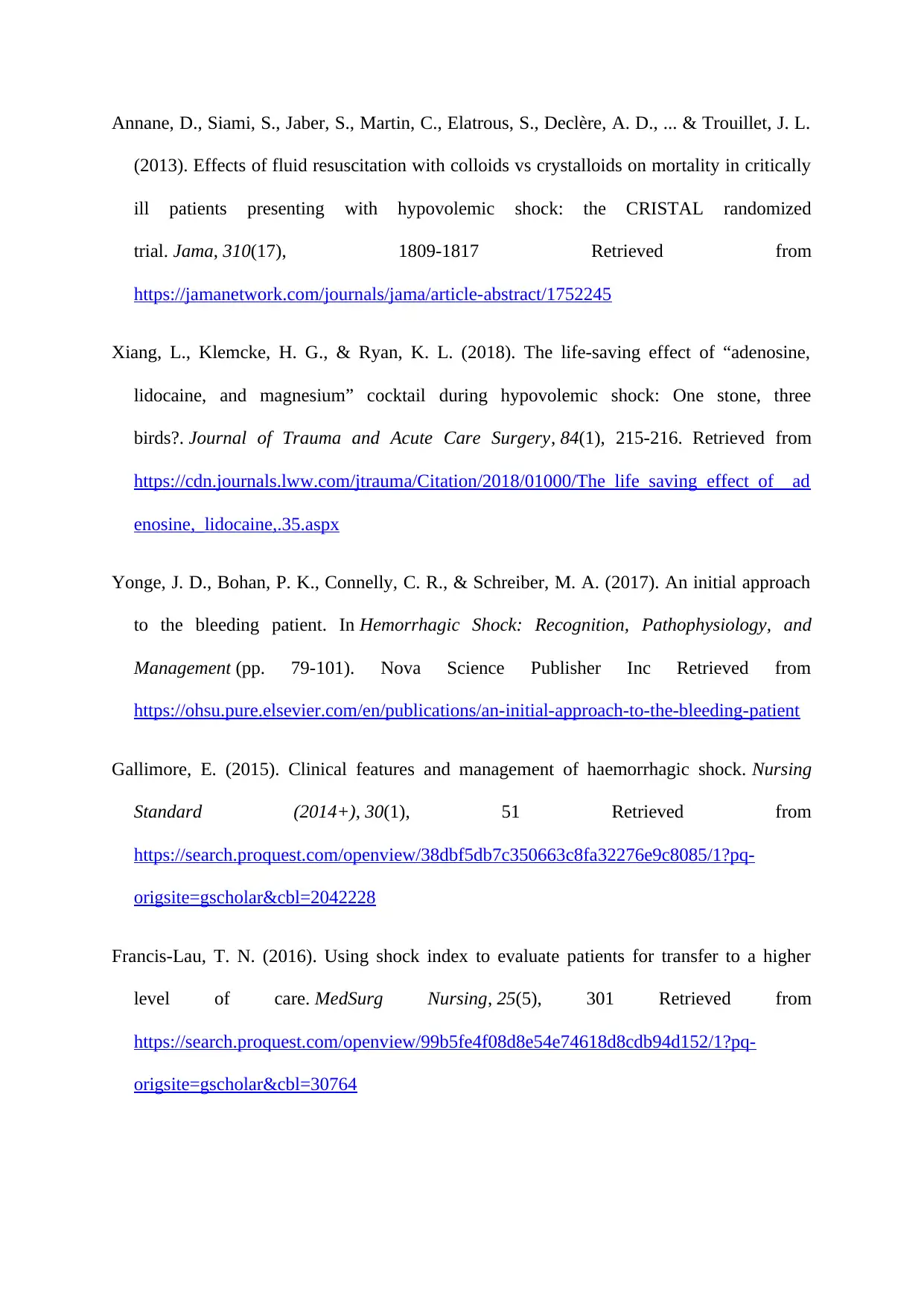
Annane, D., Siami, S., Jaber, S., Martin, C., Elatrous, S., Declère, A. D., ... & Trouillet, J. L.
(2013). Effects of fluid resuscitation with colloids vs crystalloids on mortality in critically
ill patients presenting with hypovolemic shock: the CRISTAL randomized
trial. Jama, 310(17), 1809-1817 Retrieved from
https://jamanetwork.com/journals/jama/article-abstract/1752245
Xiang, L., Klemcke, H. G., & Ryan, K. L. (2018). The life-saving effect of “adenosine,
lidocaine, and magnesium” cocktail during hypovolemic shock: One stone, three
birds?. Journal of Trauma and Acute Care Surgery, 84(1), 215-216. Retrieved from
https://cdn.journals.lww.com/jtrauma/Citation/2018/01000/The_life_saving_effect_of__ad
enosine,_lidocaine,.35.aspx
Yonge, J. D., Bohan, P. K., Connelly, C. R., & Schreiber, M. A. (2017). An initial approach
to the bleeding patient. In Hemorrhagic Shock: Recognition, Pathophysiology, and
Management (pp. 79-101). Nova Science Publisher Inc Retrieved from
https://ohsu.pure.elsevier.com/en/publications/an-initial-approach-to-the-bleeding-patient
Gallimore, E. (2015). Clinical features and management of haemorrhagic shock. Nursing
Standard (2014+), 30(1), 51 Retrieved from
https://search.proquest.com/openview/38dbf5db7c350663c8fa32276e9c8085/1?pq-
origsite=gscholar&cbl=2042228
Francis-Lau, T. N. (2016). Using shock index to evaluate patients for transfer to a higher
level of care. MedSurg Nursing, 25(5), 301 Retrieved from
https://search.proquest.com/openview/99b5fe4f08d8e54e74618d8cdb94d152/1?pq-
origsite=gscholar&cbl=30764
(2013). Effects of fluid resuscitation with colloids vs crystalloids on mortality in critically
ill patients presenting with hypovolemic shock: the CRISTAL randomized
trial. Jama, 310(17), 1809-1817 Retrieved from
https://jamanetwork.com/journals/jama/article-abstract/1752245
Xiang, L., Klemcke, H. G., & Ryan, K. L. (2018). The life-saving effect of “adenosine,
lidocaine, and magnesium” cocktail during hypovolemic shock: One stone, three
birds?. Journal of Trauma and Acute Care Surgery, 84(1), 215-216. Retrieved from
https://cdn.journals.lww.com/jtrauma/Citation/2018/01000/The_life_saving_effect_of__ad
enosine,_lidocaine,.35.aspx
Yonge, J. D., Bohan, P. K., Connelly, C. R., & Schreiber, M. A. (2017). An initial approach
to the bleeding patient. In Hemorrhagic Shock: Recognition, Pathophysiology, and
Management (pp. 79-101). Nova Science Publisher Inc Retrieved from
https://ohsu.pure.elsevier.com/en/publications/an-initial-approach-to-the-bleeding-patient
Gallimore, E. (2015). Clinical features and management of haemorrhagic shock. Nursing
Standard (2014+), 30(1), 51 Retrieved from
https://search.proquest.com/openview/38dbf5db7c350663c8fa32276e9c8085/1?pq-
origsite=gscholar&cbl=2042228
Francis-Lau, T. N. (2016). Using shock index to evaluate patients for transfer to a higher
level of care. MedSurg Nursing, 25(5), 301 Retrieved from
https://search.proquest.com/openview/99b5fe4f08d8e54e74618d8cdb94d152/1?pq-
origsite=gscholar&cbl=30764
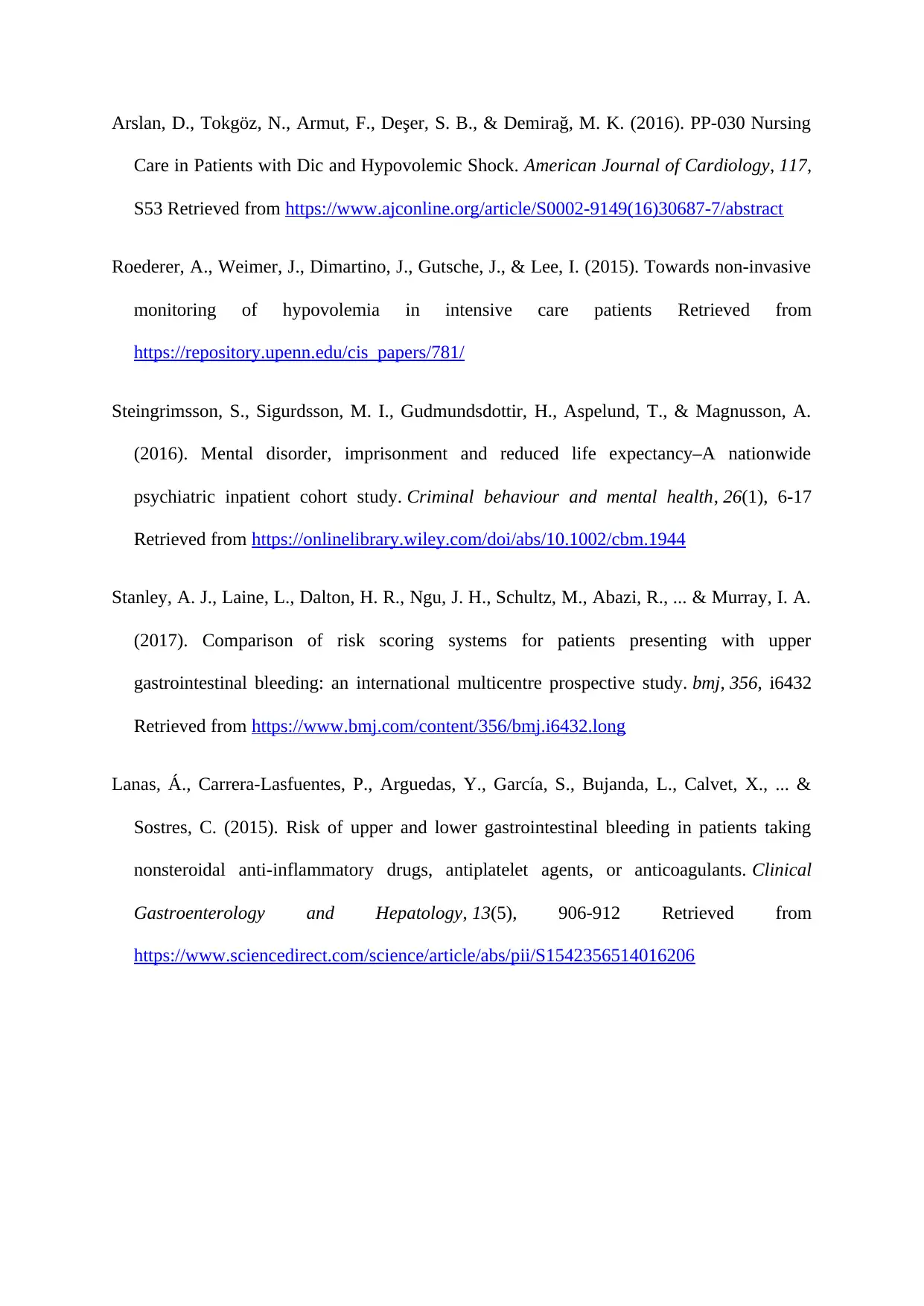
Arslan, D., Tokgöz, N., Armut, F., Deşer, S. B., & Demirağ, M. K. (2016). PP-030 Nursing
Care in Patients with Dic and Hypovolemic Shock. American Journal of Cardiology, 117,
S53 Retrieved from https://www.ajconline.org/article/S0002-9149(16)30687-7/abstract
Roederer, A., Weimer, J., Dimartino, J., Gutsche, J., & Lee, I. (2015). Towards non-invasive
monitoring of hypovolemia in intensive care patients Retrieved from
https://repository.upenn.edu/cis_papers/781/
Steingrimsson, S., Sigurdsson, M. I., Gudmundsdottir, H., Aspelund, T., & Magnusson, A.
(2016). Mental disorder, imprisonment and reduced life expectancy–A nationwide
psychiatric inpatient cohort study. Criminal behaviour and mental health, 26(1), 6-17
Retrieved from https://onlinelibrary.wiley.com/doi/abs/10.1002/cbm.1944
Stanley, A. J., Laine, L., Dalton, H. R., Ngu, J. H., Schultz, M., Abazi, R., ... & Murray, I. A.
(2017). Comparison of risk scoring systems for patients presenting with upper
gastrointestinal bleeding: an international multicentre prospective study. bmj, 356, i6432
Retrieved from https://www.bmj.com/content/356/bmj.i6432.long
Lanas, Á., Carrera-Lasfuentes, P., Arguedas, Y., García, S., Bujanda, L., Calvet, X., ... &
Sostres, C. (2015). Risk of upper and lower gastrointestinal bleeding in patients taking
nonsteroidal anti-inflammatory drugs, antiplatelet agents, or anticoagulants. Clinical
Gastroenterology and Hepatology, 13(5), 906-912 Retrieved from
https://www.sciencedirect.com/science/article/abs/pii/S1542356514016206
Care in Patients with Dic and Hypovolemic Shock. American Journal of Cardiology, 117,
S53 Retrieved from https://www.ajconline.org/article/S0002-9149(16)30687-7/abstract
Roederer, A., Weimer, J., Dimartino, J., Gutsche, J., & Lee, I. (2015). Towards non-invasive
monitoring of hypovolemia in intensive care patients Retrieved from
https://repository.upenn.edu/cis_papers/781/
Steingrimsson, S., Sigurdsson, M. I., Gudmundsdottir, H., Aspelund, T., & Magnusson, A.
(2016). Mental disorder, imprisonment and reduced life expectancy–A nationwide
psychiatric inpatient cohort study. Criminal behaviour and mental health, 26(1), 6-17
Retrieved from https://onlinelibrary.wiley.com/doi/abs/10.1002/cbm.1944
Stanley, A. J., Laine, L., Dalton, H. R., Ngu, J. H., Schultz, M., Abazi, R., ... & Murray, I. A.
(2017). Comparison of risk scoring systems for patients presenting with upper
gastrointestinal bleeding: an international multicentre prospective study. bmj, 356, i6432
Retrieved from https://www.bmj.com/content/356/bmj.i6432.long
Lanas, Á., Carrera-Lasfuentes, P., Arguedas, Y., García, S., Bujanda, L., Calvet, X., ... &
Sostres, C. (2015). Risk of upper and lower gastrointestinal bleeding in patients taking
nonsteroidal anti-inflammatory drugs, antiplatelet agents, or anticoagulants. Clinical
Gastroenterology and Hepatology, 13(5), 906-912 Retrieved from
https://www.sciencedirect.com/science/article/abs/pii/S1542356514016206

1 out of 10
Related Documents
Your All-in-One AI-Powered Toolkit for Academic Success.
+13062052269
info@desklib.com
Available 24*7 on WhatsApp / Email
![[object Object]](/_next/static/media/star-bottom.7253800d.svg)
Unlock your academic potential
© 2024 | Zucol Services PVT LTD | All rights reserved.





